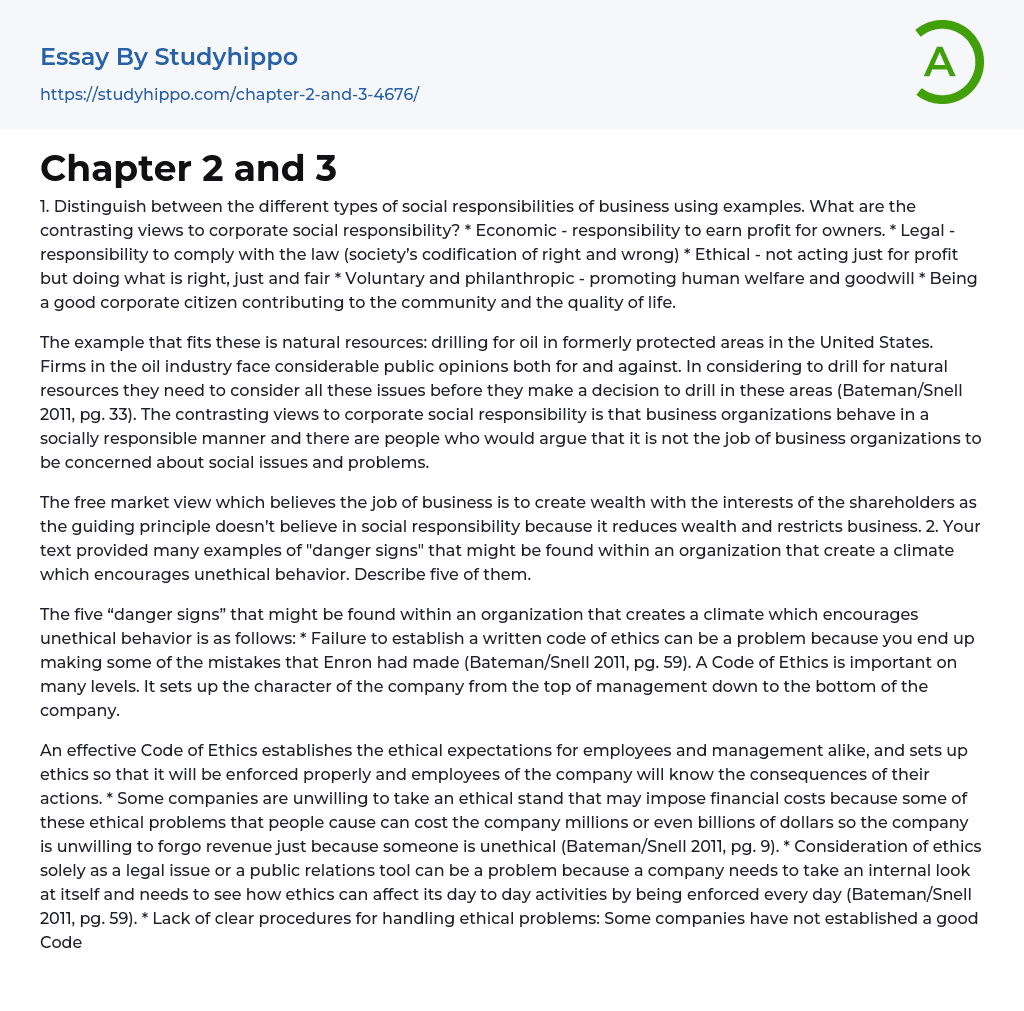1. Distinguish between the different types of social responsibilities of business using examples. What are the contrasting views to corporate social responsibility? * Economic - responsibility to earn profit for owners. * Legal - responsibility to comply with the law (society’s codification of right and wrong) * Ethical - not acting just for profit but doing what is right, just and fair * Voluntary and philanthropic - promoting human welfare and goodwill * Being a good corporate citizen contributing to the community and the quality of life.
The example that fits these is natural resources: drilling for oil in formerly protected areas in the United States. Firms in the oil industry face considerable public opinions both for and against. In considering to drill for natural resources they need to consider all these issues before they make a decision to drill in these areas (Ba
...teman/Snell 2011, pg. 33). The contrasting views to corporate social responsibility is that business organizations behave in a socially responsible manner and there are people who would argue that it is not the job of business organizations to be concerned about social issues and problems.
The free market view which believes the job of business is to create wealth with the interests of the shareholders as the guiding principle doesn’t believe in social responsibility because it reduces wealth and restricts business.
2. Your text provided many examples of "danger signs" that might be found within an organization that create a climate which encourages unethical behavior. Describe five of them.
The five “danger signs” that might be found within an organization that creates a climate which encourages unethical behavior is as follows:
* Failure to establish a writte
code of ethics can be a problem because you end up making some of the mistakes that Enron had made (Bateman/Snell 2011, pg. 59). A Code of Ethics is important on many levels. It sets up the character of the company from the top of management down to the bottom of the company.
An effective Code of Ethics establishes the ethical expectations for employees and management alike, and sets up ethics so that it will be enforced properly and employees of the company will know the consequences of their actions.
* Some companies are unwilling to take an ethical stand that may impose financial costs because some of these ethical problems that people cause can cost the company millions or even billions of dollars so the company is unwilling to forgo revenue just because someone is unethical (Bateman/Snell 2011, pg. 9).
* Consideration of ethics solely as a legal issue or a public relations tool can be a problem because a company needs to take an internal look at itself and needs to see how ethics can affect its day to day activities by being enforced every day (Bateman/Snell 2011, pg. 59).
* Lack of clear procedures for handling ethical problems: Some companies have not established a good Code of Ethics that would clearly show the consequences of their actions and their responsibilities as an employee (Bateman/Snell 2011, pg. 59). Responsiveness to the demands of shareholders at the expense of other constituencies (Bateman/Snell 2011, pg. 59). This can be bad because it shows that the company is just trying to look out for the bottom line (money) rather than considering the overall health of the company.
3. List the six
components that an Effective Ethics Program will include. The six components to making an ethics code effective are as follows.
* Involve those who have to live with the code in writing it (Bateman/Snell 2011, pg. 61).
* Focus on real-life situations that employees can relate to (Bateman/Snell 2011, pg. 1).
* Keep it short and simple, so it is easy to understand and remember (Bateman/Snell 2011, pg. 61).
* Write about values and shared beliefs that are important and that people can really believe in (Bateman/Snell 2011, pg. 61).
* Set the tone at the top, having executives talk about and live up to the statements (Bateman/Snell 2011, pg. 61).
* Establish statements that don’t differ from reality this can make your statement a joke to employees (Bateman/Snell 2011, pg. 61). References Bateman, Thomas S and Snell, Scott A (2011). M: Management, second edition. New York: The McGraw – Hill Companies.
- Chief Executive Officer essays
- Convenience Store essays
- Firm essays
- Training And Development essays
- Unilever essays
- Variable Cost essays
- Virgin Group essays
- Bargaining essays
- Entity essays
- Pest analysis essays
- Values of Life essays
- Ethical dilemma essays
- Normative Ethics essays
- Virtue Ethics essays
- Belief essays
- Deontology essays
- Moral essays
- Virtue essays
- Work Ethic essays
- Perfect Competition essays
- Underwriting essays
- Synergy essays
- Valuation essays
- Business Law essays
- Contract essays
- Consumer Protection essays
- Property essays
- Ownership essays
- Agreement essays
- Common Law essays
- Contract Law essays
- Justice essays
- Security essays
- Tort Law essays
- United States Constitution essays
- Crime essays
- Lawsuit essays
- Treaty essays
- Family Law essays
- Marijuana Legalization essays
- Constitution essays
- War on Drugs essays
- Court essays
- Jury essays
- Police essays
- Protection essays
- Community Policing essays
- Criminal Law essays
- Judge essays
- Lawyer essays




